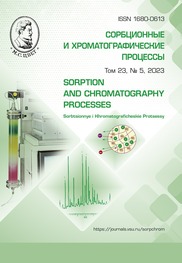Effective Ion Charges in Ion Exchangers and Electrolyte Solutions
Abstract
Structures, effective numbers of charges and molecular orbitals of ion pairs and representative fragments of a sulfocation exchanger in various ionic forms were calculated by the non-empirical quantum chemical method of LCAO MO. The effective charges of ions in accordance with the principles of the molecular orbital method were fractional values. For contact ion pairs, where the effective ion charges were experimentally measured by X-ray absorption spectroscopy, we obtained full agreement with the calculated values. The charge numbers of cations and anions differed in both hydrate-separated and ion-exchange systems due to the fact that the oxygen atoms of hydrated water molecules influenced the formation of molecular orbitals. According to the obtained values of the numbers of charges and interionic distances, the energies of the electrostatic interaction of ions were calculated using the integral form of Coulomb's law. Experimental values of the energies of chemical bonds of counterions and fixed ions were obtained using the conductometric contact-difference method when measuring the specific electrical conductivity of MK-40 cation exchange membranes in the range of 20-50oC and according to the Arrhenius equation. The coordination of experimental and calculated chemical bond energies in the ion exchanger was achieved after the addition of hydrogen bond energy to the electrostatic interaction energy. In order to be able to completely nonempirically calculate the energies of chemical bonds in an ion exchanger, we took the value of the hydrogen bond energy as the excitation energy of the first energy level of deformation vibrations of water molecules having a value of 19.4 kJ/mol. A comparison of the contribution of the electrostatic interaction to the total binding energy of alkali metal cations with a fixed ion showed its small role in ion exchange and membrane transport, so that in the first approximation we can say that the transfer of alkali metal cations is determined by the breaking of the hydrogen bond. For cations of a larger charge (calcium), the electrostatic energy already makes a significant contribution, and for trivalent ions, the energies of the Coulomb interaction and hydrogen bonding are close to each other. The soliton mechanism of translation of the energy of deformation vibrations along a chain of water molecules is considered, which allows explaining the decrease in energy when several hydrogen bonds are broken.







